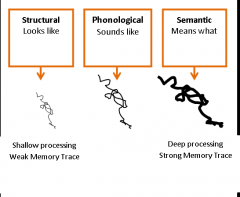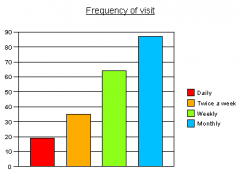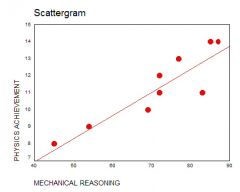![]()
![]()
![]()
Use LEFT and RIGHT arrow keys to navigate between flashcards;
Use UP and DOWN arrow keys to flip the card;
H to show hint;
A reads text to speech;
38 Cards in this Set
- Front
- Back
|
Cognitive Psychology |
Role of Cognition and Cognitive Processes in Human Behaviour |
|
|
What is Cognition? |
Mental thinking processes needed to make sense of the world: Perception Language Thinking Memory Problem Solving Attention |
|
|
What does Cognition Involve? |
Behaviour is Influenced byCognition
Learning : Development : Speech
Our higher level of cognition is what differentiates humans from other animals |
|
|
Information Processing
"the brain is like a computer" |
Input : information enters via the senses
Process : Information is processed and stored
Output : Information is recalled/ retreived |
|
|
Multi Store Model of Memory Diagram |

|
|
|
Control Processes |
Attention and Rehearsal |
|
|
Multi Store Model of Memory Theory Atkinson and Shiffrin |
3 Systems : Capacity + Duration + Encoding Sensory Memory : 5 stores one for each sense. Only information attended to enters the STM, otherwise it is lost Short Term Memory : 5-9 bits of information held for 18-30 seconds. moves on to the LTM store through rehearsal Long Term Memory : Possibly Infinite + variety of memories - uses different types of coding: visual (flexible systems) + semantic (meaning) |
|
|
Supporting Research Multi-Store Model AO2 |
The theory is supported by experimental research giving it credibility + Peterson & Peterson found that blocking rehearsal leads to poor recall +Brown-Peterson technique is used to block rehearsal by using interference tasks before recall = Only 10% of information retained; suggesting that rehearsal is needed to prevent decay of memory trace |
|
|
Flaws Multi-Store Model AO2 |
- All supporting research is done in laboratory conditions = lacks ecological validity - task & setting are artificial - Theory is not a complete explanation of memory. it cannot explain why we remember things without rehearsal; scent worn by someone special - Rehearsal is to simple of a process to account for the transfer of info from STM to LTM - the model ignores factors such as effort and strategy used for learning- unlike Levels of processing model which accounts for |
|
|
Levels of Processing Theory of Memory Craik and Lockhart |
The level of processing determines whether the information is remembered: what a person does with the incoming information
Structural processing, based on appearance is shallow = poor recall Phonemic Processing, auditory processing Semantic Processing, based on meaning is deeper = better recall
Deeper processing = more durable the memory = better recall
|
|
|
Levels of Processing Diagram |

|
|
|
Types of Rehearsal |
Maintenance Rehearsal Information is Retained Temporarily due to simple rehearsal or repetition - shallow processing
Elaborative Rehearsal Expands upon info & creates lasting memories - Deeper Processing = lasting memory traces |
|
|
Memory Traces |
- Incoming stimuli pass through a series of analysing mechanisms - Memory Traces are a product of how stimuli are analysed - Strength of trace depends on: Attention paid to stimulus Depth of Processing carried out Connections with existing knowledge |
|
|
Application of Memory Theories |
+ Levels of Processing has application to real life e.g. Schools: Students can be taught to revise semantically by making meaningful notes rather than simply reading information + Levels of Processing model moved understanding of memory forward. it widened the focus from seeing LTM as a simple storage unit as in the multi-store model, to seeing it as a complex processing system. It showed encoding is not a simple straightforward process. + Multi-Store Model shows us the importance of rehearsal in revising. + Cue dependency can be supported by real life incidences such as remembering all the words to a song that we haven't heard in years |
|
|
Supporting Research Levels of Processing Theory AO2 |
+ Supported by scientific research enhancing credibility. Craik and Tulving found that more words were remembered after semantic processing than after structural processing which supports LOP theory. There were 80% recognition following semantic processing and 18% after processing for capital letters (structural). + Hyde and Jenkins also found that in conditions such as sating a word for its pleasantness participants remembered more words that those in other conditions. They claimed that this was because these tasks involved semantic processing whereas other tasks didn't. |
|
|
Conflicting Research Levels of Processing Theory AO2 |
- Morris et al found that semantic processing did not always lead to the best recall and it depended on how recall was measured: recognition - semantic best, but with rhyming recognition - phonemic was best - Glenburg et al showed that although rote rehearsal did not enhance free recall, it did improve recognition of stimuli. This poses problems for the LOP model as it suggests that rote rehearsal can improve on type of retrieval. |
|
|
Flaws Levels of Processing Theory AO2 |
- All supporting research is done in laboratory conditions = lacks ecological validity - task & setting are artificial - Deeper processing requires more effort and time, so it is difficult to know which factor influences the results - Eysenck and Eysenck argue even shallow processing could lead to better processing/recall If the material was distinctive; you may see something so distinctive that it creates a strong mental image |
|
|
Cue Dependency theory of Forgetting Tulving |
Problem of Accessibility We forget information because we don't have the right cues to retrieve it Information is in LTM but temporarily inaccessible
If cues are absent during retrieval forgetting will occur Context Dependant Cues - Environmental cues State Dependant Cues - Internal cues - State of mind |
|
|
Encoding Specificity Principle |
Suggest that the more similar a cue that is present at the time of recalling to a cue that was present at the time of learning the more likely the person will remember the information
"The greater the similarity between the encoding event & retrieval event, the greater the likelihood of recalling the original memory" |
|
|
Supporting Studies Cue Dependency theory of Forgetting AO2 |
+ Godden and Baddeley found recall was 50% higher when context was the same when recalling as when learning. In the same context participants recalled on average 12 words, in a different context it was 8. + Baker et al found that chewing gum during learning and recall enhanced recall. +Lang et al found that after learning a list of words when in a state of fear, participants recalld more words when the fear was induced again than when they were in a relaxed state |
|
|
Flaws Cue Dependency theory of Forgetting AO2 |
- Baddeley argues that context dependant forgetting only occurs if the contexts during learning and recalling are vastly different. E.g. material learned in a classroom and then recalled in an ice rink will be poorer than if the material was recalled in a library - Some supporting research is done in laboratory conditions = lacks ecological validity - task & setting are artificial |
|
|
Trace Decay |
Problem of Availability Memories cause physical changes in the brain, without rehearsal the memory engrams decay. Repeated firing causes a structural change in the synapses. Rehearsal of repeated firing maintains the memory in STM until a structural change is made = the trace is fragile and will disintegrates if not constantly refreshed through practice, causing forgetting to occur : Trace will decay in around 20 seconds without rehearsal |
|
|
Engram |
When a new memory is acquired and learning occurs a physical change happens in the neural network of the memory system creating a memory trace or engram |
|
|
Supporting Studies Trace Decay AO2 |
+ Peterson and Peterson research shows that all but 10% of memories were lost after 18 seconds. They argued that a time delay where rehearsal was prevented caused information to decay. + Penfield tried to help patients with epilepsy and during surgery identified places where memories are stored, which may be evidence for the existence of engrams |
|
|
Flaws Trace Decay AO2 |
- A problem with trace decay is that we do recall things we have not rehearsed the fragrance worn by someone special. - It is difficult to measure that trace decay is the reason for forgetting, Some experiments claiming to show trace decay may be affected by confounding variables such as interference, thus reducing validity - Waugh and Norman set out to support trace decay but actually concluded interference is the most likely cause of forgetting |
|
|
Laboratory Experiment |
Research conducted in an artificial environment Independent variable is manipulated Dependant variable is measures
Other variables are kept constant and controlled Limit extraneous and confounding variables |
|
|
Laboratory Experiment AO2 |
Validity Low Ecological Validity due to the artificial conditioned whereby participants may not act naturally Demand Characteristics may occur - participants change their behaviour in accordance with what they think the experimenter is studying Reliability Laboratory standardisation means greater ability to replicate the study |
|
|
Field Experiment |
Research is conducted in the participants natural environment Independent variable is manipulated Independent variable is measured
Variables are less controlled than in laboratory conditions Often participants are naive and are unaware that they are taking part |
|
|
Field Experiment AO2 |
Validity Good ecological validity as participants are in their natural environmental giving more naturalistic behaviour - especially if they're naive Participants are naive and no demand characteristics to affect validity Reliability variables cannot be controlled as well as in a laboratory experiment and it may be harder to replicate the study precisely |
|
|
Natural Experiment |
Research is conducted in the participants natural environment The independent variable is naturally occurring The dependant variable is measured
Researcher must wait for the event to naturally ocour - almost no control over variables |
|
|
Natural Experiment AO2 |
Validity Good ecological validity as participants are in their natural environment giving more natural behaviour Reliability Replication is difficult as the natural IV may not occur in the same way again and there is reduced control over variables compared to a laboratory experiment |
|
|
Independent Groups Design Participant Designs |
AO1 Participants are assigned to one of the experimental conditions. There may be several groups including a control group but participants take part in only one . AO2 + No order effects as different participants do different conditions - Participant variables as different participants used in each condition -More participants are needed which can increase time and difficulty |
|
|
Repeated Measures Design Participant Designs |
AO1 Participants complete more than one condition involved in the study AO2 + fewer participants needed than other designs, such as independent groups design, which is easier and may save time + Participant variables are less likely to occur - same participants used - Having small amount of participants reduces generalisability - order effects may occur such as practise effects, fatigue or boredom. This can be solved by Counter Balancing and Randomisation |
|
|
Matched Pairs Design Participant Designs |
AO1 Similar to independent groups designs participants only take part in one condition. Each participant is "matched" with a participant in a different condition who shares similar characteristics relating to the variables AO2 + participant variables are reduced via careful sampling and matching. Validity is enhanced and cause and effect conclusions can be drawn + There are no order effects to reduce validity - more difficult and time consuming obtaining and matching variables |
|
|
Correlational Design Participant Designs
|
AO1 Variables are identified for investigation and measured to see if there is a relationship between the variables. AO2 + Quantitative data is obtained which is objective + Secondary data can be used which is easier and less time consuming - There is no control over potentially confounding variables: cause and effect cannot be established - problems may occur on how the variables are measured -validity |
|
|
Bar Charts |

Shows discrete categories IV (categories) on X axis DV (frequency) on Y axis |
|
|
Scattergram |

Measuring relationships between variables Pattern reveals types of correlation: + or -
|
|
|
Hypotheses |
Directional Hypothesis: One-tailed - Outcome of study is predicted
Non-Directional Hypothesis: Two-tailed- difference is predicted - possible outcomes - direction of outcome is not predicted
Experimental Hypothesis: Prediction regarding the outcome of the experiment IV and DV are operationalized |

